

Horsehair worms share the very elongated worm-like body of many other ‘worms’ (e.g., certain nematodes, annelids), but they have some unique physical features that cause them to be classified in the phylum Nematomorpha.įigure 2. Moist conditions are favorable to the development of this nematode and highest populations develop in relatively wet, grassy areas. Mating occurs at this time and ultimately the egg-bearing females emerge to lay eggs on foliage to repeat the cycle. It then has a long period as a free living nematode in the soil, living many years. Within the soil the nematode molts to the adult stage. Recently exited nematodes are sometimes seen in mid to late summer, often in a small puddle of water. Upon death the nematodes exit the host and move into the soil. The feeding by this nematode seriously stresses the infected grasshopper, functionally sterilizing it and usually causing premature death. Several nematodes may develop within a single insect and when they have completed development they may pack the body. There it feeds on the blood (hemolymph) and grows, completing this stage of development in one to three months. Within the grasshopper, the egg hatches and the young nematode burrows into the body cavity of the insect. Grasshoppers become infected when they incidentally consume the eggs as they feed. During this time they lay tiny golden-brown eggs which they attach to plants. The adult nematodes are sometimes seen as they crawl on plants, usually following rainy periods in late spring. The head area of females is reddish-brown. The overall body color is very pale brown. It is extremely large, 5 to 20 cm, far larger than the nearly microscopic entomopathogenic nematodes often used to control various soil insect pests (see fact sheet 5.573, Insect Parasitic Nematodes). ( Photo courtesy of John Capinera.)Ī roundworm of the phylum Nematoda, Mermis nigrescens, develops as an internal parasite of grasshoppers (and perhaps earwigs). The Grasshopper Nematode ( Mermis nigrescens)įigure 1.

Both are harmless to humans but may attract attention and cause concern. Two unusual, very long ‘worms’ that are occasionally encountered are horsehair worms and the nematode parasite of grasshoppers, Mermis nigrescens.

The common name ‘horsehair worm’ is derived from its occasional occurrence in livestock water troughs.

With very few exceptions, horsehair worms will only be found in water.Moist conditions are favorable to the development of Mermis nigrescens and highest populations develop in relatively wet, grassy areas.Horsehair worms and the grasshopper nematode parasite, Mermis nigrescens, are both harmless to humans.


 0 kommentar(er)
0 kommentar(er)
